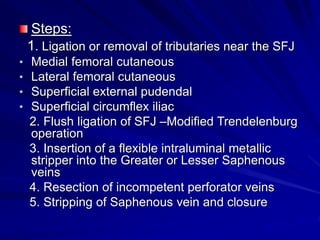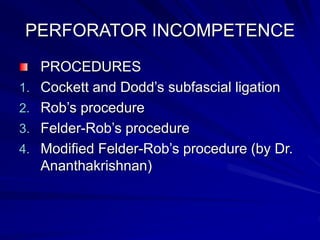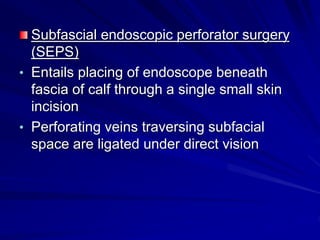varicose veins-Investigations & Management
- 2. INVESTIGATIONS INVASIVE NON INVASIVE VENOGRAPHY 1.DOPPLER USG 2.PLETHYSMOGRAPHY 3.COLOUR DOPPLER
- 3. DOPPLER ULTRASOUND Procedure ’ü▒With patient in standing position,the hand held doppler probe is placed at the saphenofemoral junction(SFJ) ’ü▒With other hand,the examiner gently squeezes the calf to propel blood forward- this is heard as a ŌĆśwhooshŌĆÖfrom the loudspeaker of the doppler machine
- 5. PLETHYSMOGRAPHY This is a graphical representation of the pressures in the superficial and deep veins at rest and during exercise various techniques include: 1. strain gauge plethysmography 2.photoplethysmography 3.impedance plethysmography 4.air plethysmography
- 6. VENOGRAPHY Both ascending and descending venography have to be done to give to give the same information as colour doppler Good alternative in places where there are no ultrasound facilities
- 7. ASCENDING VENOGRAPHY USES 1.To diagnose perforator incompetence 2.To map out the deep venous system 3.To diagnose deep vein thrombosis-seen as a filling defect
- 8. procedure Tourniquet is tied just above the medial maleoli to prevent blood flow into the superficial veins Non-ionic contrast is injected into the dorsal venous arch Normally,only the deep venous system can be seen
- 9. DESCENDING VENOGRAPHY Uses: To test for the competence of Saphenofemoral Junction Procedure
- 10. DUPLEX ULTRASOUND IMAGING(COLOUR DOPPLER) Involves use of higher resolution B-mode USG with Doppler USG to obtain images of arteries, veins and simultaneously measure flow in these vessels. The machine represents blood flow as a colour map that is superimposed on the greyscale image of the vessel. Forward flow which occurs when the calf is squeezed is seen as blue in the colour flow map. When incompetent veins are present reverse flow is seen as red when the calf is released.
- 11. Advantages 1)Is the most appropriate investigation to obtain the anatomy and physiology of the venous system. 2)All the lower limb vessels may be imaged. 3)The origin of varicose veins and venous ulceration can be identified. 4)If DVT is present the thrombus can be seen.
- 13. Conservative treatment: Indications- 1)Uncomplicated Varicose veins 2)Patient unwilling or unfit for surgery Bizzgards Regimen ŌĆó Avoid prolonged standing ŌĆó Foot end elevation at night ŌĆó Crepe bandage during the day ŌĆó Exercise to strengthen calf muscles
- 14. Injection-Compression treatment: Used to treat Varicose veins in the absence of Junctional incompetence. Aim: To inject a small volume of effective Sclerosant into veins lumen to destroy the intima. Solution: 3% Sodium Tetredecyl Sulphate Procedure: 0.5ml of Sclerosant is injected into the empty vein at points of control-Sites at which incompetent perforators join the superficial veins. After injection external compression has to be applied.
- 15. Disadvantages: 1)Local pain and Periphlebitis 2)Reccurence: Rates upto 30% have been reported Causes: 1)Presence of SFJ incompetence 2)Failure to apply external compression
- 16. SURGERY FOR VARICOSE VEINS Indications 1)Symptoms of aching heaviness and cramps 2)Complications of venous stasis i.e. Pigmentation, dermatitis, ulceration, thrombosis 3)Large Varicosities subjected to trauma 4)Cosmetic concern
- 17. Objectives: 1)Releive symptoms 2)Alleviate stasis complications 3)Restore normal venous physiology 4)Improve cosmetic appearance
- 18. Principles of Surgery ŌĆó All incompetent superficial veins and perforators to be thoroughly removed to prevent recurrence ŌĆó Veins having a potential to develop varicosities should also be removed ŌĆó Special care to be taken not to damage or destroy normal competent Greater or Lesser Saphenous veins as they may be needed for future Bypass procedures ŌĆó Superficial varices that follow DVT may be the only route for the venous drainage of the lower limbs hence should not be removed until the patency of the deep veins are established
- 19. PROCEDURE OF STRIPPING OF VEIN Pre Op ŌĆō All veins have to be carefully and accurately marked with an indelible pencil Anesthesia - General/Regional Position ŌĆō Supine with legs elevated to 15 to 20┬░ to minimize bleeding Incision: 1st - Groin incision just below the inguinal crease medial to femoral artery pulsation 2nd ŌĆō Small transverse incision placed anterior and proximal to medial malleolus and transverse incision on the distal Saphenous vein
- 20. Steps: 1. Ligation or removal of tributaries near the SFJ ŌĆó Medial femoral cutaneous ŌĆó Lateral femoral cutaneous ŌĆó Superficial external pudendal ŌĆó Superficial circumflex iliac 2. Flush ligation of SFJ ŌĆōModified Trendelenburg operation 3. Insertion of a flexible intraluminal metallic stripper into the Greater or Lesser Saphenous veins 4. Resection of incompetent perforator veins 5. Stripping of Saphenous vein and closure
- 23. Precautions during stripping surgery 1.Tributaries of saphenous vein at the SFJ have to be removed first 2.Stripper may encounter obstruction due to tortuosities at the site of perforators 3.Stripper may enter the deep venous system through one of the perforators 4.Care is taken to avoid damage to the Saphenous nerve which lies adjacent to the vein from the ankle to knee Nerve damage causes sensory loss or traumatic neuritis of medial aspect of ankle
- 24. MULTIPLE STAB AVULSION TECHNIQUE (Ambulatory phlebectomy) ŌĆó This is done as an alternative to stripping of greater saphenous vein after flush ligation of SFJ ŌĆó At the points of greatest tortuosity, tiny incisions are made and the vein is picked up with a special hook and clamped on both sides, then avulsed ŌĆó This is done at multiple points till the whole vein is removed ŌĆó Advantages: Complication of injury to the saphenous nerve is prevented Extremely useful for residual clusters after Saphenectomy
- 25. Post Op: 1.Patient to ambulate on first post op day 2.Bandages are remove on second post op day for inspection of wound 3.Aambulation is permitted only with elastic external support for the first two weeks
- 26. PERFORATOR INCOMPETENCE PROCEDURES 1. Cockett and DoddŌĆÖs subfascial ligation 2. RobŌĆÖs procedure 3. Felder-RobŌĆÖs procedure 4. Modified Felder-RobŌĆÖs procedure (by Dr. Ananthakrishnan)
- 27. NEWER TREATMENTS Endovenous Laser treatment (EVLT) ŌĆó Done under strict LA ŌĆó Permanently closes the vein while leaving it in place ŌĆó Laser is delivered into the vein via fine Fibreoptic probe through a fine skin nick and the probe is guided via USG ŌĆó Successful treatment depends on heating of veins ŌĆó Lasers used are Diode, Nd-YAG, Alexandrite ŌĆó Precaution-The laser device is used with the cooling of the skin with cool gel or chilled air to decrease risk of injury to skin
- 29. Subfascial endoscopic perforator surgery (SEPS) ŌĆó Entails placing of endoscope beneath fascia of calf through a single small skin incision ŌĆó Perforating veins traversing subfacial space are ligated under direct vision





























